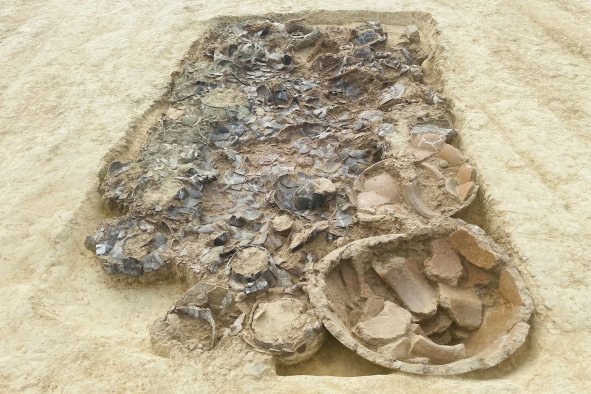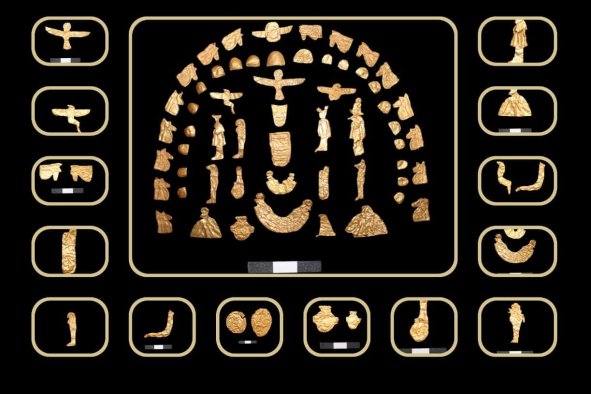A prehistoric human skeleton buried alongside a number of wild animal remains may represent the burial of a "shaman" who died around 12,000 years ago, a study has proposed.
The burial was excavated in 2019 at the archaeological site of a Neolithic settlement called Çemka Höyük (meaning the "mound by the water") in Turkey, study author Ergül Kodaş with Mardin Artuklu University told Newsweek. The site is located in the district of Dargeçit, Mardin province, southeastern Turkey, on the left bank of the Tigris River.
A number of burials have been identified at the settlement, including one dubbed ÇH2019/05. Found inside the remains of a roundhouse structure, the burial dates to around 9300 B.C. during a period known as the Pre-Pottery Neolithic A (PPNA). The find—along with others at the site—is significant because it is helping shed light on burial customs during this period, according to the study, which was published in the journal L'Anthropologie.
Although the southern part of the ÇH2019/05 burial was partially damaged due to road construction between Çemka Höyük and the Tigris River, most of it remained intact. The grave was covered with long, flat limestone block, which is—to the knowledge of the authors—"very unusual" for a PPNA burial.
The individual inside was buried in a prone position, lying on the right side, in a northwest-southeast orientation and facing west. Anthropological analysis of the skeleton confirmed that the individual was an adult female, aged between 25 and 30 at the time of death.
Intriguingly, the woman was buried with a number of animal remains. The researchers identified several bones (including a skull) of an extinct cattle species known as the aurochs, as well as the remains of a small ruminant, a partridge bone, a canid bone and a marten bone.
While open to interpretation, the nature of the burial and the associated animal remains indicate that the woman may have been a shaman or was at least buried by someone who was practicing shamanism, according to the study. As a result, the burial may represent one of the earliest known examples of its kind in a Neolithic context from the Anatolian peninsula, the authors conclude.
"Considering the fact that the female individual and the animal bones were deposited together in one burial, we may assume some symbolic relations between the animals and the hunter-gatherer-fishers of Çemka Höyük, who had already embarked towards a sedentary life," the authors wrote in the study. "It might be argued that the relationship was based on the early sedentary peoples' new perspectives towards the animal world surrounding their environment in view of species to tame, herd and manage."
ÇH2019/05 appears to be the only burial of its kind at Çemka Höyük, indicating that the woman was treated differently from other members of the community, and possibly had special status. It could be argued that she had a special connection with the mythical world, according to the researchers.
The circumstances of this "unique" burial indicate that the woman may have been engaged in shamanistic practices, which involved communication between the human world and that of the "spirits", the researchers argue.
"In general, it is said that this negotiation always comes with a cost," the authors wrote in the study. "In this regard, a shaman differs from ordinary people, and may appear as a charismatic, occasionally religious, but possibly as well 'mad' figure of a particular social group. It is very likely that such persons were different also in their habit and appearance. They may have had a handicap or visual markers that made them different and perhaps [were] lonely and socially marginalized [as well] despite, or because of, their role as a traveller between worlds."
"For this reason, in many traditional societies 'shamans' are buried with different funeral ceremonies compared to the funerary rites of ordinary members of their society."
Among the other features that can be associated with characteristics of shamanistic practice is the choice of particular animal bones that were deposited in the burial. For example, the skull of the aurochs in the grave could be a representation of the imagined power of this animal, the authors said.
"Taken all our arguments into account we strongly believe that burial C¸H 2019/5 at Çemka Höyük fits within the definition of shaman burial traditions," the authors wrote.
It is also possible, given some aspects of the burial, that the community wanted to ensure the (potential) former shaman stayed in the world of the dead, fearing that she might return as a bad spirit, the researchers said. The auroch's skull may have been deposited in the burial to guard her remains, while the limestone slab could have been designed to prevent her from leaving the grave, for example.
Other prehistoric burials have previously been found with characteristics indicating that the community feared the return of the deceased.
Do you have a tip on a science story that Newsweek should be covering? Do you have a question about archaeology? Let us know via science@newsweek.com.
Disclaimer: The copyright of this article belongs to the original author. Reposting this article is solely for the purpose of information dissemination and does not constitute any investment advice. If there is any infringement, please contact us immediately. We will make corrections or deletions as necessary. Thank you.



